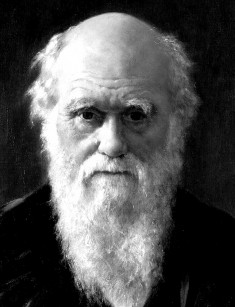
Charles Darwin: biography
Charles Robert Darwin is a naturalist, a pioneer of the theory of the Origin of Species on the Earth from a common ancestor through the evolution of each species. He is the author of the book On the Origin of Species, the theory of the origin of man, the terms of natural and sexual selection, the first ethological book The Expression of the Emotions in Man and Animals, the theory of the causes of evolution.
Charles Darwin was born on February 12, 1809, in Shropshire, England, in the Darwin Mount House estate in Shrewsbury. Robert Darwin, the boy’s father, was a doctor, financier, and a son of naturalist Erasmus Darwin. Mother Susannah Darwin, nee Wedgwood, was the daughter of the artist, Josiah Wedgewood. There were six children in the Darwin family. The family attended the Unitarian Church, but Charles's mother was a parishioner of the Anglican church before marriage.
In 1817, Charles went to school. At the age of eight, Darwin studied natural science and took the first steps in collecting. In the summer of 1817, the boy’s mother died. The father sent sons Charles and Erasmus to the Anglican Shrewsbury School in 1818.
Charles did not make progress in studies. He was not good at languages and literature. The main passion of the boy was the collecting and hunting. The teachings of his father and teachers did not force Charles to study well, and eventually, they gave up on him. Later, the young Darwin had another hobby – chemistry. The head of the gymnasium even reprimanded Darwin for it. Charles Darwin graduated the School with bad results.
Upon graduation in 1825, Charles, along with his brother Erasmus, entered the University of Edinburgh Medical School. The young man had worked as an apprentice doctor at his father’s before.
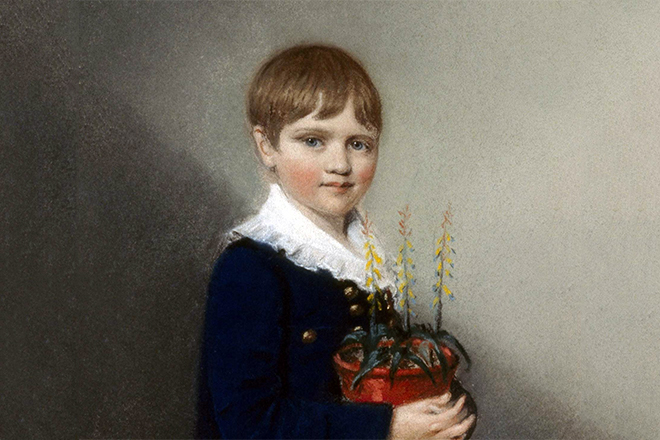
Darwin studied at the University of Edinburgh for two years. During this time, the future scientist understood that medicine is not his vocation. The student neglected lectures and was carried away with making stuffed animals. Charles's teacher was freed slave John Edmonstone, who had accompanied naturalist Charles Waterton in the trip to the rainforest.
Darwin made his first discoveries in the field of the anatomy of marine invertebrates. The young scientist presented his works in March 1827 at the meeting of the Plinian Student Society. He joined it in 1826. Young Darwin started studying materialism in this society. At that time, he assisted Robert Edmond Grant. He attended Robert Jameson’s natural history course, where he learned geology, worked with collections belonging to the museum of the University of Edinburgh.
Darwin’s father was upset with the news about his son's neglect of studying. He understood that Charles would not be a doctor. Robert Darwin sent him to Christ's College, Cambridge. Although Plinian society greatly shook Darwin's belief in the church, he did not resist his father's will and in 1828 passed the entrance examinations to Cambridge.
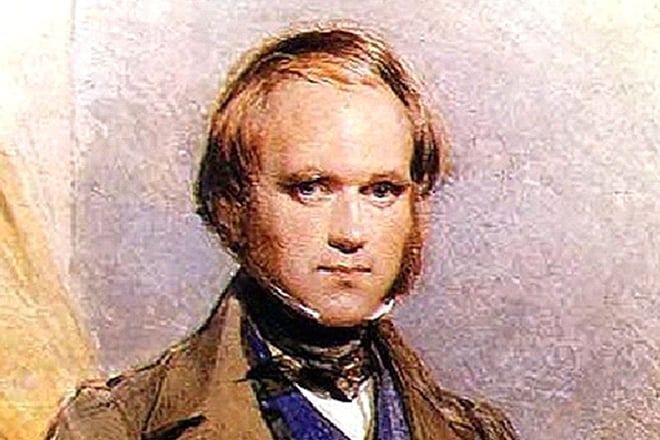
Studying at Cambridge was not too exciting. The student spent time hunting and riding. There was a new hobby – entomology. Charles joined the group of collectors of insects. The future scientist made friends with Professor John Stevens Henslow, who showed him the amazing world of botany. Henslow introduced Darwin to the leading naturalists of the time.
Darwin did his best in learning the missed material on the main subjects before the final exams. He took the 10th place after the final examination.
Traveling
After graduation in 1831, Charles Darwin stayed for some time in Cambridge. He studied William Paley’s Natural Theology and Alexander von Humboldt’s Personal Narrative. These books inspired Darwin to travel to the tropics to study the natural sciences in practice. In preparation for traveling, Charles joined Adam Sedgwick’s geology course and then traveled with him to North Wales to map strata.
After arriving from Wales, Darwin got a letter from Professor Henslow with a recommendation to Robert FitzRoy, who was the captain of the expedition Royal Navy Beagle ship. The ship went on a trip to South America, and Darwin could take the position of a naturalist in the crew. However, the position was not paid. Charles's father objected to the trip, and only the approval of Charles’s uncle, Josiah Wedgwood II, saved the situation. The young naturalist went on a round-the-world trip.
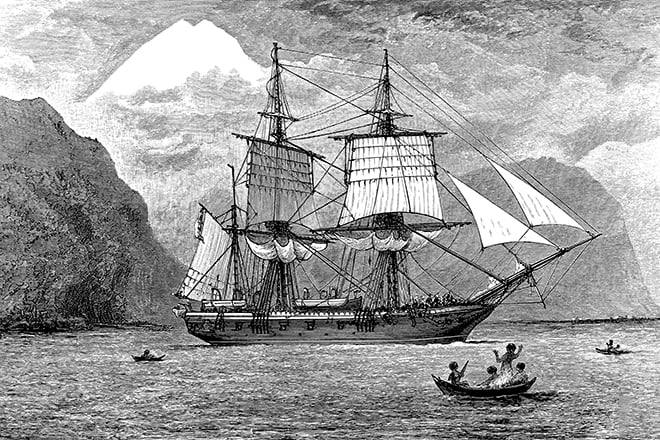
The journey began in 1831 and ended on October 2, 1836. The crew made cartographic surveys of the coasts. Darwin spent time investigating geology and making natural history collections on the shore. He kept careful notes of his observations. When he had an opportunity, the naturalist sent copies of the records to Cambridge. During the journey, Darwin collected a vast collection of animals, a large part of them was assigned to marine invertebrates. He described the geology of a number of coasts.
Near the islands of Cape Verde, Darwin made a discovery about the effect of the time on the geological changes which he would use in the works on geology in the future.
In Patagonia, he discovered fossil bones of an extinct mammal of Megatherium. The presence beside modern seashells indicated recent extinction of the species. The discovery brought great interest among scientists in England.
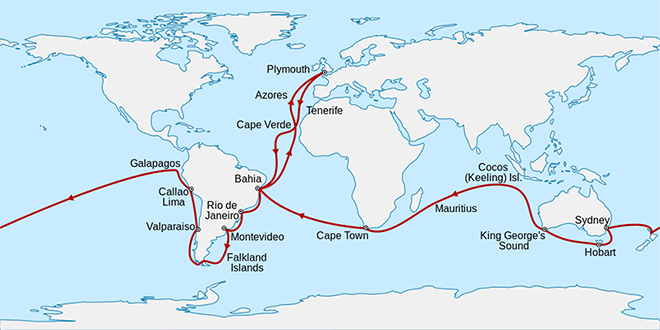
The study of the stepped plain of Patagonia with its ancient layers of the Earth led Darwin to the conclusion that the statements in Lyell's work "on the constancy and extinction of species" were incorrect.
Near the coast of Chile, the Beagle crew experienced an earthquake. Charles saw that the land had been raised above the sea level. In the Andes, he found shells of marine invertebrates, which helped the scientist to discover the growth of barrier reefs and atolls due to the diastrophic movement of the Earth crust.
In the Galapagos Islands, Darwin noticed differences between local animal species from the mainland specimens and representatives of neighboring islands. The object of the study was the Galapagos tortoises and mockingbirds.

In Australia, the strange marsupial animals and platypus seemed so unusual for the animal world of other continents that Darwin seriously thought about two distinct Creators.
Charles Darwin visited Cocos Islands, the Cap-Vert, the island of Tenerife, Brazil, Argentina, Uruguay, Tierra del Fuego. The scientist created works Journal and Remarks (1839), Zoology of the Voyage of H.M.S. Beagle (1840), The Structure and Distribution of Coral Reefs (1842) which were based on the results of the collected information. He described an interesting natural phenomenon Penitentes (special snow formation on the Andes glaciers).

After returning from the journey, Darwin began collecting information about the species change. Living in a very religious environment, the scientist understood that his theory undermined the accepted norms of the existing world order. He believed in God as a supreme being, but he was completely disappointed with Christianity. He finally stopped to go to church after the death of daughter Ann in 1851. Darwin continued to help the church and provide support to the parishioners, however, while the family was going to the church service, he went for a walk. Darwin called himself an agnostic.
In 1838, Charles Darwin became Secretary of the London Geological Society. He held this position until 1841.
On the Origin of Species
In 1837, Charles Darwin began to keep a diary, classifying plant varieties and breed of domestic animals. He wrote down his thoughts on natural selection there. The first notes on the origin of species appeared in 1842.
On the Origin of Species is a chain of arguments that support the theory of evolution. The essence of the study is the gradual development of populations of species through natural selection. The principles written in the work were called "Darwinism" in the scientific community.
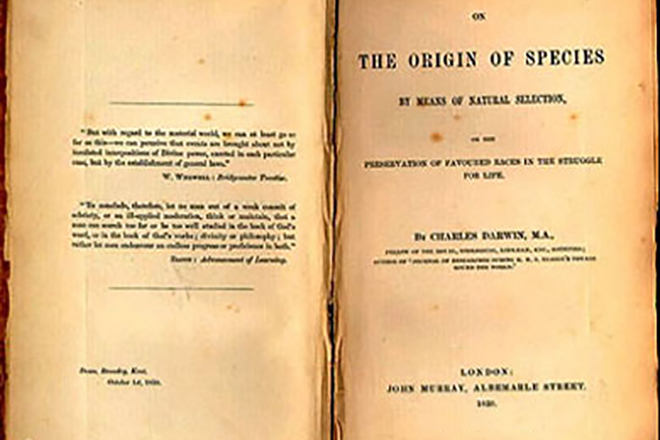
In 1856, the preparation of an expanded version of the book began. In 1859, 1250 copies of the work On the Origin of Species by Means of Natural Selection, or the Preservation of Favoured Races in the Struggle for Life were published. The book was sold in two days. During Darwin’s life, the book was published in Dutch, Russian, Italian, Swedish, Danish, Polish, Hungarian, Spanish and Serbian. Darwin's works are republished and popular now. The theory of the scientist and naturalist is still relevant and it is the basis of the modern theory of evolution.
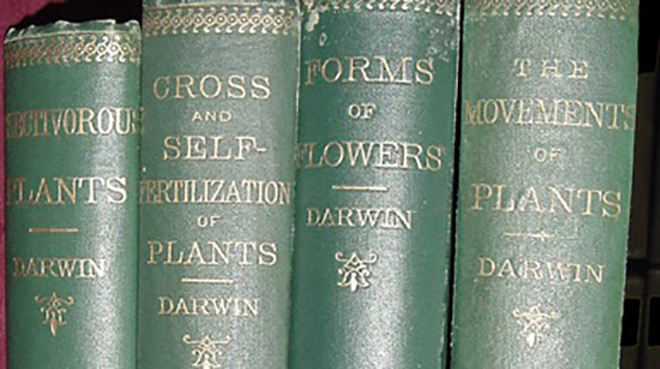
Another important Darwin’s work is The Descent of Man and Selection in Relation to Sex. The scientist developed the theory of a common ancestor of a man and the modern monkey. The scientist conducted a comparative anatomical analysis, compared embryology, and he showed on its basis the similarity of man and monkey (Pithecometra principle).
In the book The Expression of the Emotions in Man and Animals, Darwin described a man as part of the evolutionary chain. Man, as a living organism, developed from lower forms of animals.
Personal life
Charles Darwin married in 1839. His attitude towards marriage was serious. Before making a decision, he wrote down all the pros and cons. After he decided to marry, he made a marriage proposal to cousin Emma Wedgwood on November 11, 1838. Emma is the daughter of Josiah Wedgwood II, Charles’s uncle, a member of Parliament and the owner of the porcelain factory. At the time of the wedding, the bride turned 30 years old. Emma had rejected marriage proposals before. The girl was in correspondence with Darwin during the travel to South America. Emma is an educated girl. She wrote sermons for a rural school, studied music in Paris under the guidance of Frederic Chopin.

The marriage took place on January 29. The wedding was held by the bride and groom’s brother John Allen Wedgwood in the Anglican Church. The couple settled in London. On September 17, 1842, the family moved to Down, Kent.
Emma and Charles had 10 children. Children reached a high position in society. His sons George, Francis, and Horace were members of the Royal Society of England.

Three children died. Darwin linked the sickness of children with his kinship with Emma (the work On the Tendency of Species to form Varieties; and on the Perpetuation of Varieties and Species by Natural Means of Selection).
Death
Charles Darwin died at the age of 73, on April 19, 1882. He was buried in Westminster Abbey.

Emma bought a house in Cambridge after the death of her husband. Sons Francis and Horace built houses nearby. The widow lived in Cambridge during the winter. She moved to a family estate in Kent for the summer. She died on October 7, 1896. She was buried in Down, next to Darwin's brother Erasmus.
Interesting facts
• Charles Darwin was born on the same day as Abraham Lincoln.
• Darwin looks like Leo Tolstoy in the photo.
• On the Origin of Species was named so only when the sixth reissue was published.

• Darwin also discovered new species of animals from a gastronomic point of view. He tasted dishes from armadillos, ostriches, agouti, iguanas.
• Many rare species of animals are named in honor of the scientist.
• Darwin never renounced his convictions. Until the end of his days, living in a deeply religious family, he doubted religion.
• The journey of Beagle lasted for five years instead of two years.





